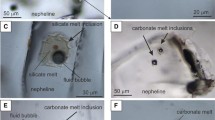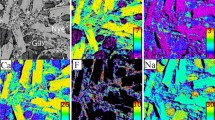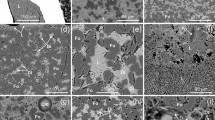Abstract
We have determined the partition coefficients of a large number of trace elements between CaTiO3 perovskite and anhydrous silicate melts at atmospheric pressure and 3 GPa. Determination of the concentration limits of Henry’s law behaviour in the CaO-Al2O3–SiO2–TiO2 system reveals that the incorporation of rare earth elements (REE) and tetravalent large ion lithophile elements (LILE4+ such as U and Th) at the Ca-site of CaTiO3 perovskite occurs with charge compensation through Ca-vacancy formation rather than by coupled substitution of Al for Ti. When melt composition is varied, we find that partition coefficients for REE and Th are strong functions of the CaO content of the melt. The observed trends are in excellent agreement with those predicted from the Ca-vacancy model. Given that they adopt the same crystal structure and have similar trace element partitioning behaviour, CaTiO3 perovskite and the deep mantle phase CaSiO3 perovskite can be considered analogous to one another. When the analogy is pursued in detail, we find that partitioning into both phases follows the composition-dependence predicted by the Ca-vacancy model. Thus, substitution of REE, U4+ and Th into CaSiO3 in the lower mantle also occurs with Ca-vacancy formation to balance charge. Furthermore when 2+, 3+ and 4+ partition coefficients for both phases are plotted as functions of CaO melt content, the trends for CaSiO3 and CaTiO3 appear to be continuous. This surprising result means that partitioning into Ca-perovskite is independent of pressure and temperature and also of whether or not the host is CaSiO3 or CaTiO3. One implication is that CaSiO3 crystallising from a peridotitic magma ocean may have partition coefficients for Th and U up to about 400. Crystallisation and sequestration of as little as 0.25 volume% of this phase in the lower mantle early in earth history would make a significant contribution to current mantle heat production.









Similar content being viewed by others
References
Blundy JD, Wood BJ (1994) Prediction of crystal–melt partition coefficients from elastic moduli. Nature 372:452–454
Corgne A, Wood BJ (2002) CaSiO3 and CaTiO3 perovskite–melt partitioning of trace elements: implications for gross mantle differentiation. Geophys Res Lett 29 DOI 10.1029/2001GL014398
Corgne A, Allan NL, Wood BJ (2003) Atomistic simulations of trace element incorporation into the large site of MgSiO3 and CaSiO3 perovskites. Phys Earth Planet Inter 139:113–127
Corgne A, Liebske C, Wood BJ, Rubie DC, Frost DJ (2004) Silicate perovskite–melt partitioning of trace elements and geochemical signature of a deep perovskitic reservoir. Geochim Cosmochim Acta 146:249–260
Hirose K, Shimizu N, van Westrenen W, Fei Y (2004) Trace element partitioning in Earth’s lower mantle and implications for geochemical consequences of partial melting at the core–mantle boundary. Phys Earth Planet Inter (in press)
Irifune T (1994) Absence of an aluminous phase in the upper part of the Earth’s lower mantle. Nature 370:131–133
Ito E, Takahashi E (1987) Melting of peridotite at uppermost lower-mantle conditions. Nature 328:514–517
Kato T, Ringwood AE, Irifune T (1988) Experimental determination of element partitioning between silicate perovskite, garnets and liquids: constraints on early differentiation of the mantle. Earth Planet Sci Lett 89:123–145
Kennedy AK, Lofgren GE, Wasserburg GJ (1994) Trace-element partition coefficients for perovskite and hibonite in meteorite compositions. Chem Geol 117:379–390
Kennedy BJ, Howard CJ, Chakoumakos BC (1999) Phase transitions in perovskite at elevated temperatures—a powder neutron diffraction study. J Phys: Condens Matter 11:1479–1488
Kesson SE, Fitz Gerald JD, Shelley JM (1998) Mineralogy and dynamics of a pyrolite lower mantle. Nature 393:252–255
Kohn SC, Schofield PF (1994) The importance of melt composition in controlling trace-element behaviour: an experimental study of Mn and Zn partitioning between forsterite and silicate melts. Chem Geol 117:73–87
Kröger FA, Vink HJ (1956) Relations between the concentrations of imperfections in crystalline solids. Solid State Phys 3:307–435
McDade P, Wood BJ, van Westrenen W, Brooker R, Gudmundsson G, Soulard H, Najorka J, Blundy J (2002) Pressure corrections for a selection of piston cylinder cell assemblies. Miner Mag 66:1021–1028
Nakamura A, Schmalzried H (1983) On the nonstoichiometry and point defects of olivine. Phys Chem Min 10:27–37
Pearce NJG, Perkins wt., Westgate JA, Gorton MP, Jackson SE, Neal CR, Chenery SP (1997) A compilation of new and published major and trace element data for NIST SRM 610 and NIST SRM 612 glass reference materials. Geostand Newslett 21:115–144
Redfern SA (1996) High-temperature structural phase transitions in perovskite (CaTiO3). J Phys: Condens Matter 8:8267–8275
Shannon RD (1976) Revised effective ionic radii and systematic studies of interatomic distances in halides and chalcogenides. Acta Crystallogr A32:751–767
Shim S-H, Duffy TS, Shen G (2000) The stability and P-V-T equation of state of CaSiO3 perovskite in the earth’s lower mantle. J Geophys Res 105:25955–25968
Simon SB, Kuehner SM, Davis AM, Grossman L, Johnson ML, Burnett, DS (1994) Experimental studies of trace element partitioning in Ca,Al-rich compositions: anorthite and perovskite. Geochim Cosmochim Acta 58:1507–1523
Wood BJ (2000) Phase transformations and partitioning relations in peridotite under lower mantle conditions. Earth Planet Sci Lett 174:341–354
Acknowledgements
AC acknowledges receipt of a PhD scholarship from the University of Bristol. We acknowledge the financial support of NERC for purchase of the LA-ICPMS and the technical support by Bruce Paterson, Stuart Kearns and Jon Wade. Comments by Dirk Frei and an anonymous reviewer, and editorial handling by Jochen Hoefs were greatly appreciated.
Author information
Authors and Affiliations
Corresponding author
Additional information
J. Hoefs
Electronic Supplementary Material
Rights and permissions
About this article
Cite this article
Corgne, A., Wood, B.J. Trace element partitioning and substitution mechanisms in calcium perovskites. Contrib Mineral Petrol 149, 85–97 (2005). https://doi.org/10.1007/s00410-004-0638-3
Received:
Accepted:
Published:
Issue Date:
DOI: https://doi.org/10.1007/s00410-004-0638-3




